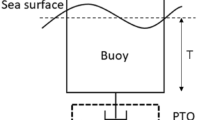Abstract
Based on two- and three-dimensional potential flow theories, the width effects on the hydrodynamics of a bottom-hinged trapezoidal pendulum wave energy converter are discussed. The two-dimensional eigenfunction expansion method is used to obtain the diffraction and radiation solutions when the converter width tends to be infinity. The trapezoidal section of the converter is approximated by a rectangular section for simplification. The nonlinear viscous damping effects are accounted for by including a drag term in the two- and three-dimensional methods. It is found that the three-dimensional results are in good agreement with the two-dimensional results when the converter width becomes larger, especially when the converter width is infinity, which shows that both of the methods are reasonable. Meantime, it is also found that the peak value of the conversion efficiency decreases as the converter width increases in short wave periods while increases when the converter width increases in long wave periods.
Similar content being viewed by others
References
Evans, D. V. A theory for wave-power absorption by oscillating bodies. Journal of Fluid Mechanics, 77, 1–25 (1976)
Budal, K. Theory of absorption of wave power by a system of interacting bodies. Journal of Ship Research, 21, 248–253 (1977)
Falcão, A. F. de O. Wave energy utilization: a review of the technologies. Renewable and Sustainable Energy Reviews, 14, 899–918 (2009)
Trevor, W., David, C., Matt, F., Max, O., Alan, H., and Michael, C. The development of Oyster—a shallow water surging wave energy converter. Proceedings of 7th European Wave Tidal Energy Conference, Portugal (2007)
Trevor, W. and Matt, F. Nearshore oscillating wave surge converters and the development of Oyster. Philosophical Transactions of the Royal Society A, 370, 345–364 (2012)
Matt, F., Whittaker, T. W. T., and van’t Hoff, J. The design of small seabed-mounted bottomhinged wave energy converters. Proceedings of 7 th European Wave and Tidal Energy Conference, Portugal (2007)
Henriques, J. C. C., Lopes, M. F. P., Lopes, M. C., Gato, L. M. C., and Dente, A. Design and testing of a non-linear power take-off simulator for a bottom-hinged plate wave energy converter. Ocean Engineering, 38, 1331–1337 (2011)
Evans, D. V. Some analytic results for two and three dimensional wave-energy absorbers. Power from Sea Waves, Academic Press, Edinburgh, 213–249 (1980)
Falnes, J. and Budal, K. Wave-power conversion by point absorbers. Norwegian Maritime Research, 6, 2–11 (1978)
Renzi, E. and Dias, F. Hydrodynamics of the oscillating wave surge converter in the open ocean. European Journal of Mechanics B/Fluids, 41, 1–10 (2013)
Renzi, E. and Dias, F. Resonant Behaviour of an oscillating wave energy converter in a channel. Journal of Fluid Mechanics, 701, 482–510 (2012)
Renzi, E. and Dias, F. Relations for a periodic array of oscillating wave energy converters. Applied Ocean Research, 39, 31–39 (2013)
Renzi, E., Abdolali, A., Bellotti, G., and Dias, F. Wave-power absorption from a finite array of oscillating wave surge converters. Renewable Energy, 6, 55–68 (2014)
Isaacson, M., Baldwin, J., Sundarlingam, P., and Yang, G. Wave interactions with double slotted barriers. Applied Ocean Research, 21, 81–89 (1999)
Koraim, A. S., Heikal, E. M., and Rageh, O. S. Hydrodynamic characteristics of double permeable breakwater under regular waves. Marine Structures, 24, 503–527 (2011)
Wang, D. J. Hydrodynamic Behaviour of Large Moored Offshore Structures During Adverse Weather Cconditions, Ph. D. dissertation, The Hong Kong Polytechnic University, Hong Kong (1993)
Caska, A. J. and Finnigan, T. D. Hydrodynamic characteristics of a cylindrical bottom-pivoted wave energy absorber. Ocean Engineering, 35, 6–16 (2008)
Wang, Y. X., Peng, J. P., Sun, H. Q., and Li, G.W. Separation of composite waves by an analytical method (in Chinese). The Oean Engineering, 21, 42–46 (2003)
Author information
Authors and Affiliations
Corresponding author
Additional information
Project supported by the Special Fund for Marine Renewable Energy of the Ministry of Finance of China (No.GD2010ZC02)
Rights and permissions
About this article
Cite this article
Wang, Dj., Qiu, Sq. & Ye, Jw. Width effects on hydrodynamics of pendulum wave energy converter. Appl. Math. Mech.-Engl. Ed. 35, 1167–1176 (2014). https://doi.org/10.1007/s10483-014-1857-6
Received:
Revised:
Published:
Issue Date:
DOI: https://doi.org/10.1007/s10483-014-1857-6
Key words
- pendulum wave energy converter
- two-dimensional eigenfunction expansion method
- three-dimensional potential flow theory
- wave energy conversion efficiency



